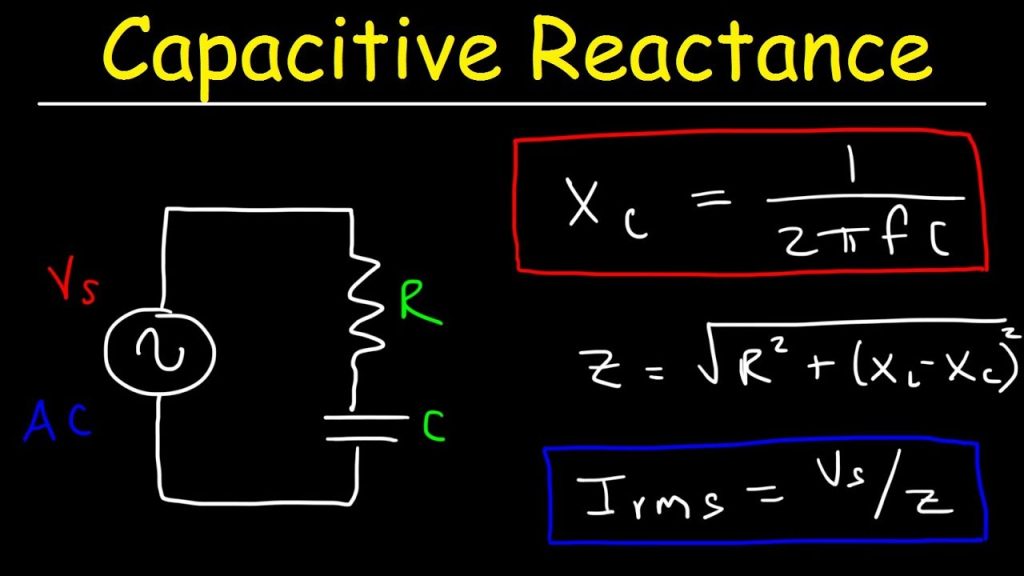Capacitive Reactance is the complex impedance of a capacitor who’s value changes with respect to the applied frequency
In the RC Network tutorial we saw that when a DC voltage is applied to a capacitor, the capacitor itself draws a charging current from the supply and charges up to a value equal to the applied voltage.
Likewise, when the supply voltage is reduced the charge stored in the capacitor also reduces and the capacitor discharges. But in an AC circuit in which the applied voltage signal is continually changing from a positive to a negative polarity at a rate determined by the frequency of the supply, as in the case of a sine wave voltage, for example, the capacitor is either being charged or discharged on a continuous basis at a rate determined by the supply frequency.
As the capacitor charges or discharges, a current flows through it which is restricted by the internal impedance of the capacitor. This internal impedance is commonly known as Capacitive Reactance and is given the symbol XC in Ohms.
Unlike resistance which has a fixed value, for example, 100Ω, 1kΩ, 10kΩ etc, (this is because resistance obeys Ohms Law), Capacitive Reactance varies with the applied frequency so any variation in supply frequency will have a big effect on the capacitor’s, “capacitive reactance” value.
As the frequency applied to the capacitor increases, its effect is to decrease its reactance (measured in ohms). Likewise as the frequency across the capacitor decreases its reactance value increases. This variation is called the capacitor’s complex impedance.
Complex impedance exists because the electrons in the form of an electrical charge on the capacitor plates, appear to pass from one plate to the other more rapidly with respect to the varying frequency.
As the frequency increases, the capacitor passes more charge across the plates in a given time resulting in a greater current flow through the capacitor appearing as if the internal impedance of the capacitor has decreased. Therefore, a capacitor connected to a circuit that changes over a given range of frequencies can be said to be “Frequency Dependant”.
Capacitive Reactance has the electrical symbol “XC” and has units measured in Ohms the same as resistance, ( R ). It is calculated using the following formula:
Capacitive Reactance
 |  Capacitive Reactance Formula |
· Where:
· Xc = Capacitive Reactance in Ohms, (Ω)
· π (pi) = 3.142 (decimal) or as 22÷7 (fraction)
· ƒ = Frequency in Hertz, (Hz)
· C = Capacitance in Farads, (F)
Capacitive Reactance Example No1
Calculate the capacitive reactance value of a 220nF capacitor at a frequency of 1kHz and again at a frequency of 20kHz.
At a frequency of 1kHz:

Again at a frequency of 20kHz:

where: ƒ = frequency in Hertz and C = capacitance in Farads
Therefore, it can be seen from above that as the frequency applied across the 220nF capacitor increases, from 1kHz to 20kHz, its reactance value, XC decreases, from approx 723Ω to just 36Ω and this is always true as capacitive reactance, XC is inversely proportional to frequency with the current passed by the capacitor for a given voltage being proportional to the frequency.
For any given value of capacitance, the reactance of a capacitor, XC expressed in ohms can be plotted against the frequency as shown below.
Capacitive Reactance against Frequency

By re-arranging the reactance formula above, we can also find at what frequency a capacitor will have a particular capacitive reactance ( XC ) value.
Capacitive Reactance Example No2
At which frequency would a 2.2uF Capacitor have a reactance value of 200Ωs?

Or we can find the value of the capacitor in Farads by knowing the applied frequency and its reactance value at that frequency.
Capacitive Reactance Example No3
What will be the value of a capacitor in farads when it has a capacitive reactance of 200Ω and is connected to a 50Hz supply.

We can see from the above examples that a capacitor when connected to a variable frequency supply, acts a bit like a “frequency controlled variable resistor” as its reactance (X) is directly proportional to frequency. At very low frequencies, such as 1Hz our 220nF capacitor has a high capacitive reactance value of approx 723.3KΩ(giving the effect of an open circuit).
At very high frequencies such as 1Mhz the capacitor has a low capacitive reactance value of just 0.72Ω (giving the effect of a short circuit). So at zero frequency or steady state DC our 220nF capacitor has infinite reactance looking more like an “open-circuit” between the plates and blocking any flow of current through it.
Voltage Divider Revision
We remember from our tutorial about Resistors in Series that different voltages can appear across each resistor depending upon the value of the resistance and that a voltage divider circuit has the ability to divide its supply voltage by the ratio of R2/(R1+R2). Therefore, when R1 = R2 the output voltage will be half the value of the input voltage. Likewise, any value of R2 greater or less than R1 will result in a proportional change to the output voltage. Consider the circuit below.
Voltage Divider Network

We now know that a capacitor’s reactance, Xc (its complex impedance) value changes with respect to the applied frequency. If we now changed resistor R2above for a capacitor, the voltage drop across the two components would change as the frequency changed because the reactance of the capacitor affects its impedance.
The impedance of resistor R1 does not change with frequency. Resistors are of fixed values and are unaffected by frequency change. Then the voltage across resistor R1 and therefore the output voltage is determined by the capacitive reactance of the capacitor at a given frequency. This then results in a frequency-dependent RC voltage divider circuit. With this idea in mind, passive Low Pass Filters and High Pass Filters can be constructed by replacing one of the voltage divider resistors with a suitable capacitor as shown.
Low Pass Filter

High Pass Filter

The property of Capacitive Reactance, makes the capacitor ideal for use in AC filter circuits or in DC power supply smoothing circuits to reduce the effects of any unwanted Ripple Voltage as the capacitor applies an short circuit signal path to any unwanted frequency signals on the output terminals.
Capacitive Reactance Summary
So, we can summarize the behaviour of a capacitor in a variable frequency circuit as being a sort of frequency controlled resistor that has a high capacitive reactance value (open circuit condition) at very low frequencies and low capacitive reactance value (short circuit condition) at very high frequencies as shown in the graph above.

It is important to remember these two conditions and in our next tutorial about the Passive Low Pass Filter, we will look at the use of Capacitive Reactance to block any unwanted high frequency signals while allowing only low frequency signals to pass.


